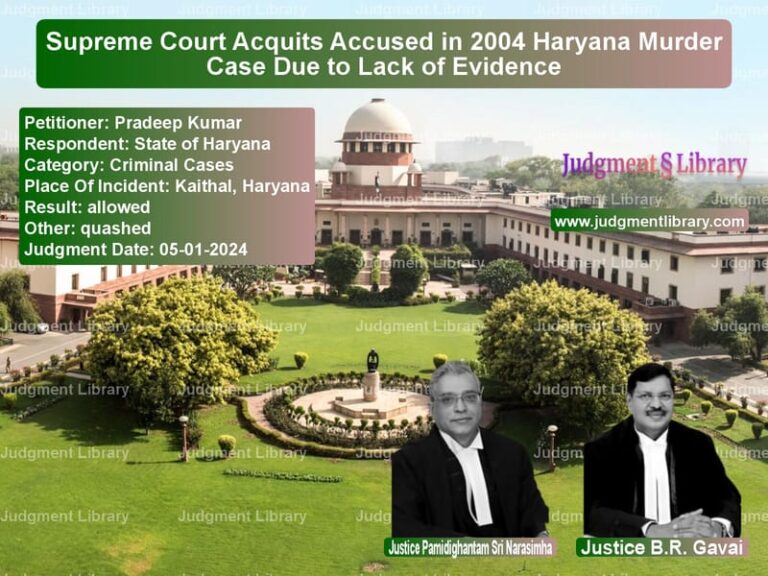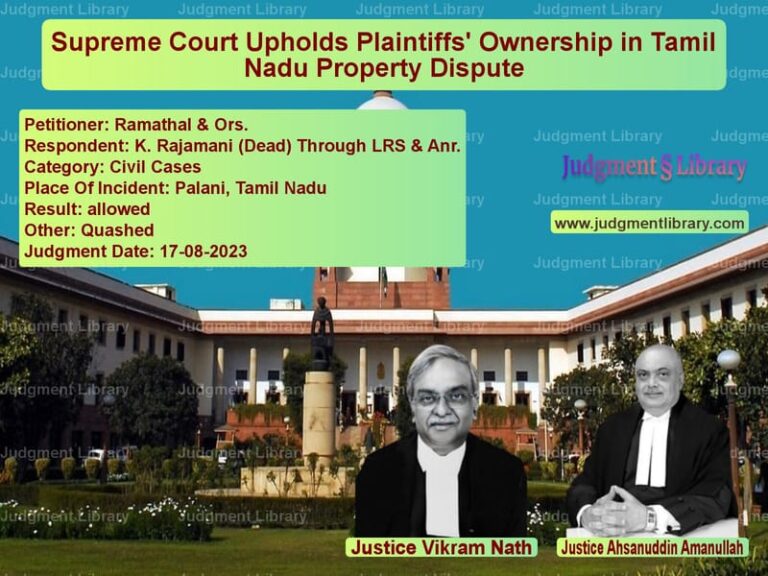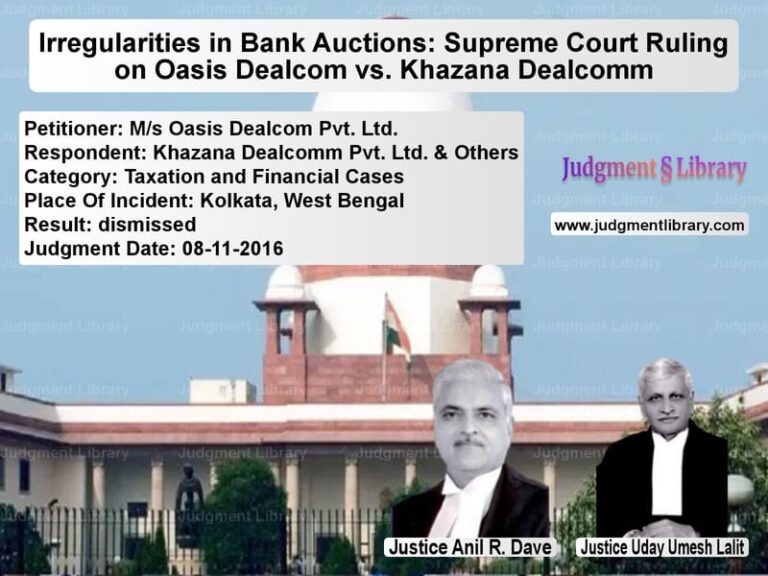Interpretation of ‘Vacant Land’ Under Urban Land Ceiling Act: Critical Legal Insights from Kewal Court Pvt. Ltd. Case
The judgment delivered in the case of M/s. Kewal Court Pvt. Ltd. and Another vs. The State of West Bengal and Others brings to focus critical issues surrounding the interpretation of the term ‘vacant land’ under the Urban Land (Ceiling and Regulation) Act, 1976. This ruling extensively examined the complexities surrounding land acquisition laws, particularly addressing the interpretations and implications of the terms within the act.
Background of the Case
The core dispute arose from the Urban Land (Ceiling and Regulation) Act, 1976 (commonly known as the Ceiling Act), enacted to impose ceilings on urban land holdings, prevent excessive concentration of urban land, and ensure equitable distribution. The appellants, M/s. Kewal Court Pvt. Ltd. and Anr., contested the classification and subsequent acquisition of their property as ‘vacant land’ by the State of West Bengal under the Ceiling Act. The contested property was located in Kolkata, falling under Category ‘A’ of Schedule I of the Ceiling Act, with a permissible ceiling limit of 500 square meters.
Initially, the Competent Authority had notified that the appellants possessed an excess ‘vacant land’ of 3115.50 square meters, which was significantly higher than the permissible limit. Consequently, a notification was issued to acquire this excess land.
Arguments by the Petitioner – M/s. Kewal Court Pvt. Ltd.
The appellants strongly contested this determination, raising several critical points:
- Incorrect Interpretation of ‘Vacant Land’: They argued that according to Section 2(q)(i) and (ii) of the Ceiling Act, land not suitable for construction under local building regulations should not be categorized as ‘vacant land’. They specifically pointed to Calcutta’s Building Regulations, restricting constructions to only 50% of the total land area.
- Presence of Structure on the Land: The appellants contended there existed a structure on the land, hence it should qualify for exemption under Section 2(q)(ii), as land appurtenant to existing buildings cannot be considered vacant.
- Misapplication of Building Regulations: The calculation method used by the authorities was claimed to be inconsistent with the statutory building regulations which stipulated construction limitations.
Arguments by the Respondents – State of West Bengal
The State authorities, represented by senior counsel Shri Rakesh Dwivedi, strongly opposed the appellants’ claims with these arguments:
- Correct Application of Law: The respondents maintained that land qualifying as vacant under the Ceiling Act was correctly determined, and argued that the definition under Section 2(q) was clear and comprehensive.
- Permissibility of Construction: According to the respondents, construction was indeed permissible under existing building regulations, covering more than 50% of the land, contrary to the appellants’ claims.
- Uniform Application of Ceiling Act: They emphasized that uniform application of the law was essential for fairness and public interest, preventing arbitrary exemptions.
Supreme Court’s Detailed Observations
In delivering its decision, the Supreme Court extensively discussed the interpretation of ‘vacant land’ as defined under Section 2(q) of the Ceiling Act.
Key Judicial Observations
Significant arguments from the judgment included:
1. True Interpretation of ‘Vacant Land’
“The words ‘vacant land’…mean land, not being land mainly used for the purpose of agriculture, in an urban agglomeration, but does not include land on which construction of a building is not permissible under the building regulations in force in the area…”
2. Exemption Scope Clarified
The judgment elaborated on Section 2(q)(i) noting explicitly:
“…land which under building regulations, zoning or otherwise is prohibited from any construction, such as green belts, parks or forests, would be completely exempted from the ambit of vacant land definition.”
3. Clarifying ‘Land Appurtenant’
“Land appurtenant to a building would mean contiguous land that remains after giving full allowance for the area left out under municipal or building regulations, subject to a maximum of 500 square meters.”
3. Importance of Proper Documentation
The court observed the need for proper and timely documentation, emphasizing:
“Failure to explicitly sanction or reject building plans by the concerned authorities within the stipulated period cannot automatically lead to classification of land as non-vacant.”
Final Ruling by the Supreme Court
Ultimately, due to the complexity and importance of interpreting Section 2(q)(i) of the Ceiling Act, the Supreme Court found it necessary to refer this matter to a larger Bench for a detailed examination to clarify the ambiguities. The Court stated:
Read also: https://judgmentlibrary.com/supreme-court-directs-fresh-adjudication-in-advertisement-tax-dispute/
“We are thus of the considered opinion that the Ceiling Act indeed is an expropriatory legislation and must receive liberal construction. This case may, therefore, be placed before Hon’ble the Chief Justice of India for appropriate directions.”
Implications of the Judgment
The Court’s ruling sets a critical direction for future cases involving interpretation of statutory terms related to urban land regulation. Key implications include:
- Need for Clarity in Urban Land Laws: Ensures uniformity in interpreting statutory terms across different jurisdictions.
- Impact on Property Developers: Clarification will directly impact real estate projects and planning within urban areas.
- Legal Precedent: This ruling emphasizes the rigorous standards required in interpreting legislation that affects property rights.
Conclusion
The Supreme Court’s decision in the Kewal Court Pvt. Ltd. vs. State of West Bengal case addresses crucial legal complexities in land ceiling laws. By referring critical points of statutory interpretation to a larger Bench, the Court aims to ensure robust legal clarity. The outcome of this reference will significantly shape the future landscape of urban land regulations, potentially impacting landowners, state authorities, and urban planning.
Petitioner Name: M/s. Kewal Court Pvt. Ltd..Respondent Name: The State of West Bengal and Ors..Judgment By: Justice Surya Kant, Justice Dipankar Datta.Place Of Incident: Kolkata, West Bengal.Judgment Date: 09-10-2023.
Don’t miss out on the full details! Download the complete judgment in PDF format below and gain valuable insights instantly!
Download Judgment: ms.-kewal-court-pvt-vs-the-state-of-west-be-supreme-court-of-india-judgment-dated-09-10-2023.pdf
Directly Download Judgment: Directly download this Judgment
See all petitions in Property Disputes
See all petitions in Landlord-Tenant Disputes
See all petitions in Contract Disputes
See all petitions in Judgment by Surya Kant
See all petitions in Judgment by Dipankar Datta
See all petitions in partially allowed
See all petitions in Remanded
See all petitions in supreme court of India judgments October 2023
See all petitions in 2023 judgments
See all posts in Civil Cases Category
See all allowed petitions in Civil Cases Category
See all Dismissed petitions in Civil Cases Category
See all partially allowed petitions in Civil Cases Category







